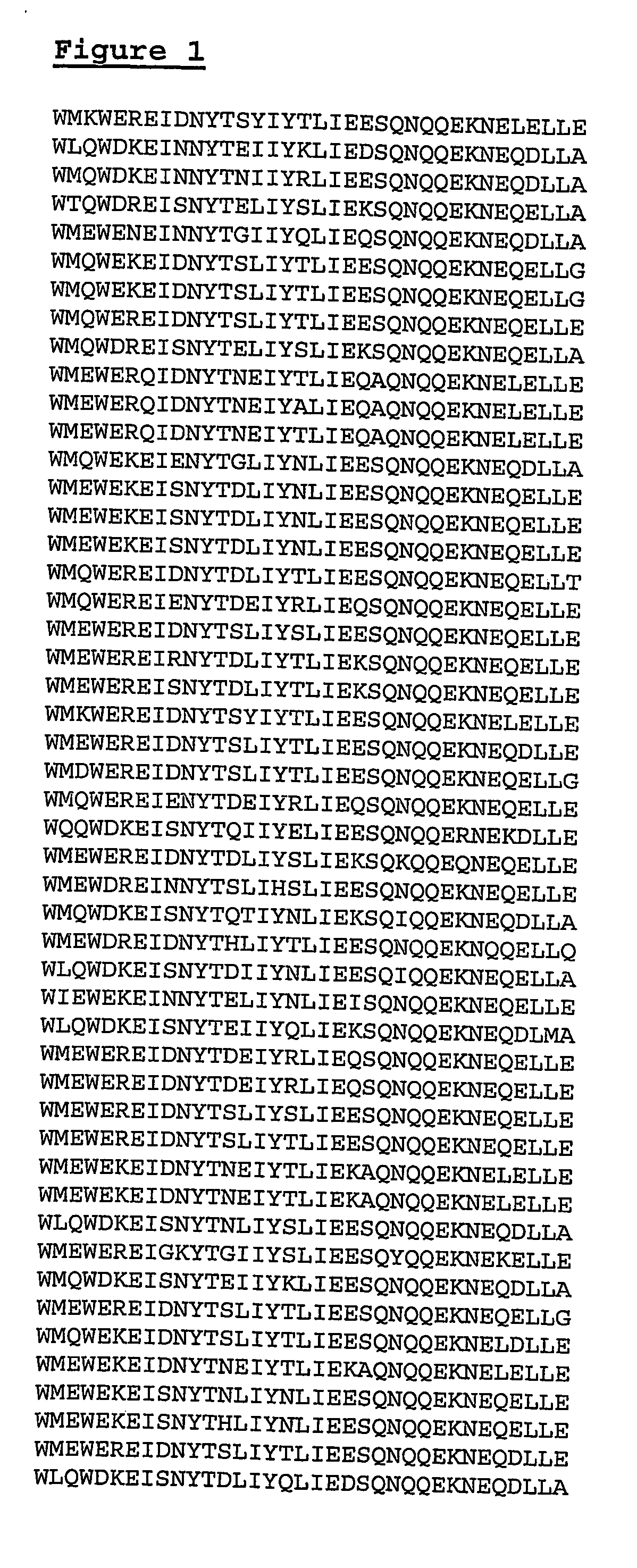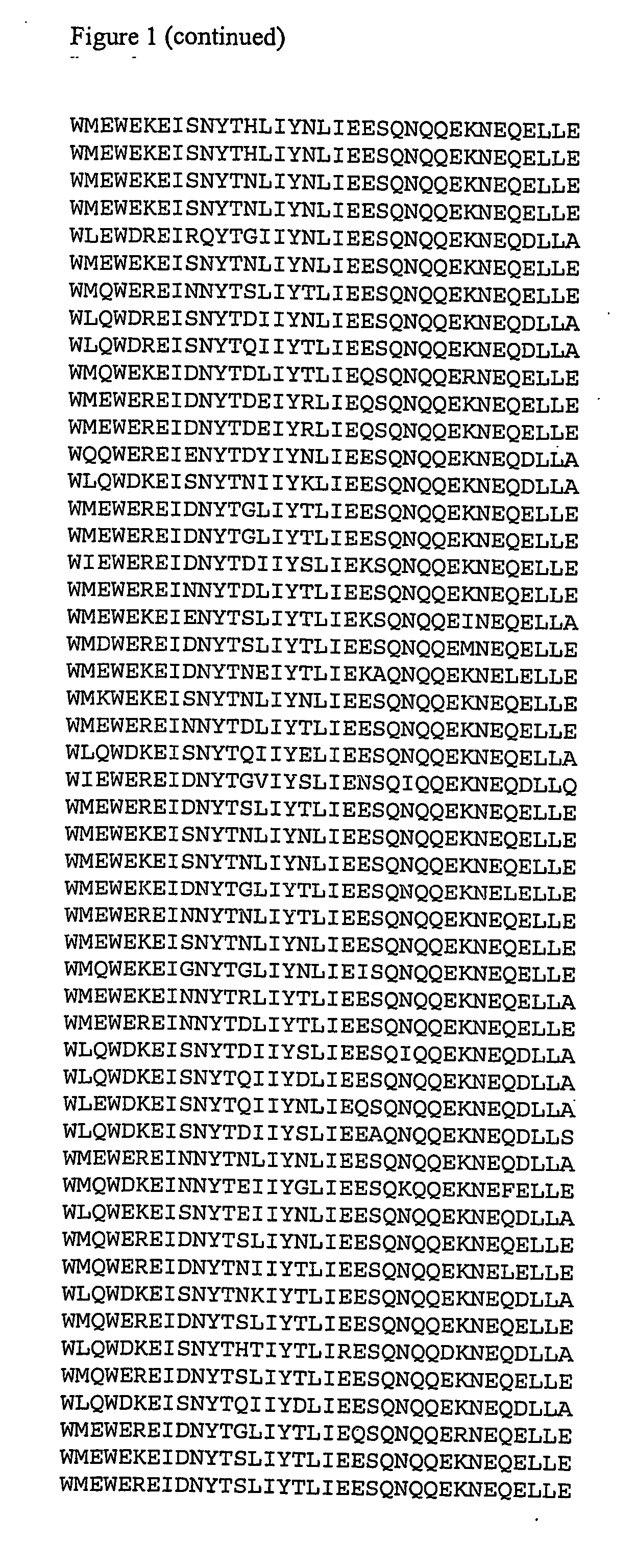Long Acting Biologically Active Conjugates
a biologically active, conjugate technology, applied in the direction of peptide/protein ingredients, peptide sources, applications, etc., can solve the problems of adverse side reactions and/or diminished efficacy, affecting the effect of drug regimens, and initial levels that exceed the desired therapeutic levels, etc., to achieve safe and non-toxic, high peak drug levels, and poor adherence to drug regimens
- Summary
- Abstract
- Description
- Claims
- Application Information
AI Technical Summary
Benefits of technology
Problems solved by technology
Method used
Image
Examples
example 1
Design and Preparation of HIV Fusion Inhibitor Peptides
[0489] Sequences of putative HIV fusion inhibitor peptides were modeled using the crystal structure of the gp41 trimeric helical fiisogenic complex (reviewed in Jiang et al, 2002). Peptide sequences were modeled to form helical segments that can fit into the grooves formed by the N-terminal triple helical core of the fusogenic complex. Evaluation of the inner binding and outer exposed surfaces of the modeled helical peptides were used to determine the sequence and composition of amino acids in the model peptides. Amino acids that have exposed side chains after complex formation are varied to improve solubility and other physical-chemical characteristics of the model peptide. Amino acids that bind to the N-terminal triple helical core are determinative of binding affinity and antiviral activity.
[0490] Most of the peptides in Tables 1 and 2 reflect changes in surface residues and were predicted to be equally potent antiviral com...
example 2
Evaluation of Antiviral Activity of Peptides
[0516] Antiviral potency of the peptides was analyzed against HIV-1 HXB2 or NLA-3 strains using a cytotoxicity assay with MT4 cells as previously described (ref 1-3) with minor modifications. MT-4 cells (1.5×104 / ml) were exposed to 200 50% tissue culture infective doses (TCID50) of viruses in the presence of various concentrations of test compound in 96 well microtiter plates and incubated at 37° C. for 5 days. Cytotoxicity of HIV was measured by the addition of 3-(4,5-dimethylthiazol-2-yl)-2,5-diphenytetrazolium bromide (MMI) solution to each well to a final concentration of 0.75 mg / ml, and incubation for 1 hour a 37° C. After incubation, cells were dissolved in isopropanoyrriton-X 100 / HCl (1000:50:25) solution. Absorbance was monitored in a microplate reader (Spectramax, Molecular Devices) at 540 rm and 690 nm. MT-4 cells were obtained from the AIDS Research and Reference Reagent Program (ARRRP, Division of AIDS, NIAID, NIH: MT-4 from D...
example 3a
Preparation of Chemically-reactive Modified HIV Fusion Inhibitor Peptides
[0521] Analogues of peptides 2 and 7 demonstrate the general applicability of the procedure for enhancing the pharmacokinetic activity of peptides with diverse sequences. SPI-30014 and SPI-70038 (see below, Table 2) were prepared using solid phase synthesis techniques as described above. Instead of acetylating the N-terminus it is reacted with Fmoc-8-amino-3,6-dioxaoctanoic acid, TCTU, DIEA for 3 h, washed as above and then reacted with 3-maleimidopropionic acid, TCTU, DIEA for 3 h. Cleavage and purification was as described above.
[0522] SPI-30014 MH+4545
[0523] SPI-70038 MH+4673
PUM
| Property | Measurement | Unit |
|---|---|---|
| Fraction | aaaaa | aaaaa |
| Mass | aaaaa | aaaaa |
| Therapeutic | aaaaa | aaaaa |
Abstract
Description
Claims
Application Information
 Login to View More
Login to View More - R&D
- Intellectual Property
- Life Sciences
- Materials
- Tech Scout
- Unparalleled Data Quality
- Higher Quality Content
- 60% Fewer Hallucinations
Browse by: Latest US Patents, China's latest patents, Technical Efficacy Thesaurus, Application Domain, Technology Topic, Popular Technical Reports.
© 2025 PatSnap. All rights reserved.Legal|Privacy policy|Modern Slavery Act Transparency Statement|Sitemap|About US| Contact US: help@patsnap.com



